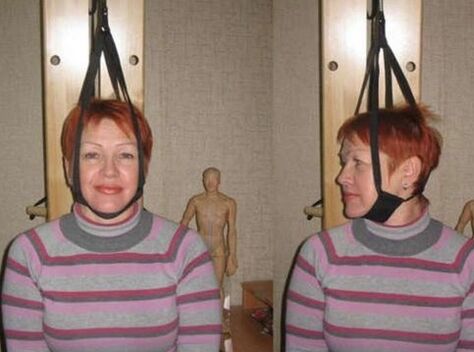Osteochondrosis of the cervical region is a dangerous disease, and if it is not treated, you can become a disabled person. Faced with this ailment, many people think about how to deal with it. Let's figure out the intricacies of the disease.

Osteochondrosis of the cervical spine is a disease that has its own symptoms, stages, causes and treatment.
The nature of the disease
Osteochondrosis of the cervical vertebra is a progressive disease, which is characterized by degenerative, as well as dystrophic changes in the discs between the vertebrae.
The cervical department is represented by the seven vertebrae and is the most mobile, but the muscle corset is poorly developed. He is responsible for the slopes of the head to the sides and its turns.
Stages of the course of the disease
The development of the disease takes place in four stages, and the degree is distinguished:
- 1 degree.The stage is characterized by instability manifested in the initial destruction of the disks.
- 2 degree.At this stage, protrusion of discs is manifested. The distance between the vertebrae is reduced, the destruction of the fiber ring begins, while pain occurs due to pinching of the nerve.
- 3 degree.The ring is finally destroyed, and hernias are formed between the vertebrae. The spine is very deformed.
- 4 degree.She is the hardest. Each movement causes severe pain. With a strong increase in bone tissue, the disease leads to disability.
The picture illustrates the stages of development of osteochondrosis of the cervical spinal canal
Important! At each stage - different symptoms and different methods of treatment are used. Doctors take measures regardless of the stage of the disease, as this allows you to improve the quality of the patient's life.
Causes of the disease
To date, a strong growth of sick ages from 18 to 30 years has been noticed. Previously, this ailment was found only in the elderly and occasionally in people under 40 years of age. The causes of cervical osteochondrosis are different.
Among the main ones stand out:
- Excess weight;
- Change of posture;
- Scoliosis of the spinal canal in the neck;
- injuries of the cervical spinal canal;
- malfunctions in the process of metabolism;
- constant lifting weights;
- poor physical training;
- stress;
- a sedentary image of life;
- the presence of infectious diseases;
- Frequent hypothermia.
If regular back pains appear, then this can signal the spine. One of the diseases may be the instability of the cervical vertebrae. What are the causes of the disease and the main symptoms? What complications can be if you do not start timely treatment?
Osteochondrosis of the cervical vertebra is closely associated with muscle spasms that limit the mobility of the vertebrae. As a result, the process of blood circulation, posture is violated. All these factors launch a dystrophic process in the discs located between the vertebrae. As a result, the nerve is pinched.
Incorrect position during sleep can lead to the development of osteochondrosis of the cervical spinal canal
Manifestation of the disease
Most often, signs of the manifestation of cervical osteochondrosis are associated with the failure of the blood circulation of the brain.
Typical are:
- dizziness in which loss of consciousness is possible;
- frequent headaches;
- Slim in the coordination of movements. Most often, the disease manifests itself in gait disturbances;
- often manifesting ringing in the ears, as well as hearing impairment;
- the appearance of snoring;
- reduction of vision;
- the appearance of hoarseness, hoarseness of the voice;
- Loss of sensitivity in the fingers.

Important! When several symptoms are manifested, consult a doctor for advice. Do not self -medicate.
Symptoms of cervical osteochondrosis
Intervertebral osteochondrosis of the cervical region is manifested by the following symptoms:
- Koreshka. The patient feels the pain that is given to the zone of blades or shoulder. He also feels tingling in his fingers, brush, forearms. These symptoms are directly related to pinches of the nerve;
With cervical osteochondrosis of the spinal canal, the pain is given to the shoulder
- back compression;
- vertebral artery;
- Irritive-Reflectory. They are expressed in acute and severe pain in the neck and occipital region, which manifests itself when sneezing, as well as after sleep or sharp turns to the right or left of the head;
- cardinal syndrome. This symptoms are similar to angina pectoris. The pain is paroxysmal and prolonged. Strengthening occurs if a cough appears, a person sneezes, as well as with sharp turns of the head.
Important! If inflammation of osteochondrosis of the cervical region occurs, then the symptoms are expressed in a brighter form.
Treatment
Osteochondrosis of the cervical spine is treated, but it takes a lot of time. In addition, it should take place in the hospital and comprehensively.
Doctors use a whole range of measures and funds in the fight against the disease. Among them:
- Hivamat is a procedure for electrostatic vibro massage on a specialized apparatus. It anesthetizes, has an anti -inflammatory effect, allows you to remove the edema and muscle tension. According to statistics, two sessions to relieve pain syndrome are enough.
- Laser therapy of MLS. The procedure is aimed at pain relief, removal of inflammation, as well as regeneration of soft tissues. The method is innovative, but successfully used to treat osteochondrosis of the cervical and other spinal canal.
- Electrophoresis. This is a procedure in which medicines under the skin are introduced using electric current pulses. It has an analgesic, anti -inflammatory effect.
- Application of ozokerite. Treatment with mountain wax and paraffin. After applying the composition, the sore spot is covered with a film. It does not cause unpleasant sensations and gives a positive effect.
Exercises for osteochondrosis of the cervical spine. Simplicity and effectiveness. A systematic approach on a daily basis is required
Important! All procedures are prescribed by a doctor depending on the degree of disease and individual characteristics of the patient. They are always selected individually.
The cervical spine in the human body is an important part, and the problems in its work are provoked by negative consequences. In addition, a neglected disease associated with the neck can gradually affect the thoracic region. Exercises for the cervical spinal column will help maintain health and resume mobility in this zone of the bone-muscular system.
In addition, the procedures are supplemented:
- analgesics, antispasmodics and anti -inflammatory drugs;
- using gels, creams, ointments for tissue restoration;
- healing physical exercises;
- reflexotherapy;
- Hirudotherapy;
- massage sessions;
- dry stretch.

Important! Most often, conservative methods are used, but, unfortunately, surgical intervention can be prescribed in difficult situations.
Dry Explosion - an effective method in the treatment of cervical osteochondrosis of the spinal column
The consequences of osteochondrosis of the cervical spinal canal
The disease can cause serious consequences, such as:
- Protabius. This complication is characterized by a protrusion of the pulpo -bone nucleus of the intervertebral disc, in which the ring does not destroy;
- The hernia of the intervertebral disc. It occurs when the fibrous ring is destroyed;
- bone vertebrae of the vertebrae;
- salt deposition;
- The appearance of sclerotic plaques inside the vessels and other disorders.
Important! Any vascular disorders are the most dangerous consequences, since the supply of the brain with blood is disturbed, which can lead to severe diseases.
Osteochondrosis of the cervical spine requires treatment. It takes a lot of time, so you need to be patient and strictly follow the recommendations and advice of a doctor.
























